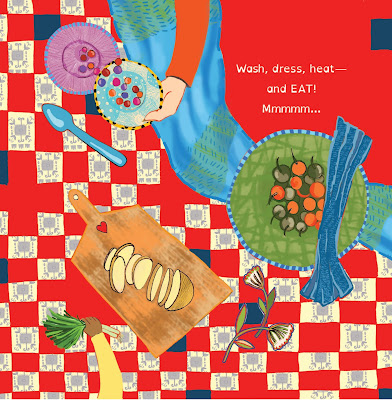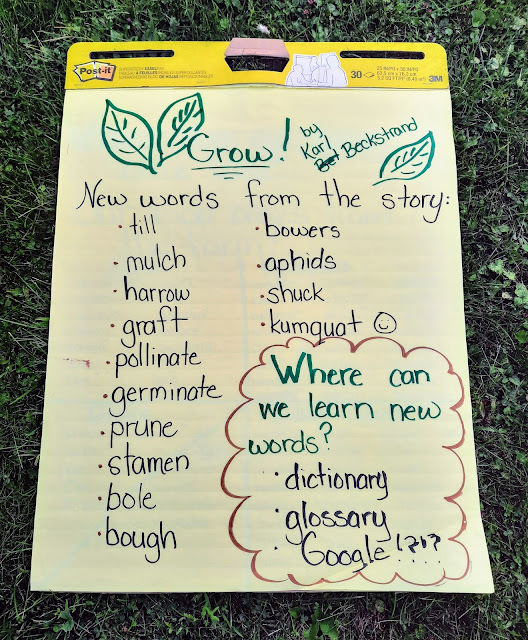A couple of weeks ago, I wrote a blog post called How to Grow Celery from Food Scraps. In that post, I talked about the disconnect children have about
their food and described a science activity you can do with them.
Since then, I learned about a new book hitting the market in October
2020. It's called
Grow! How We Get Food from Our Garden by Karl
Beckstrand. Grow! would be a good book to read with your
students to help them realize where their food comes from. Yes, food
does come from the grocery store. But before it gets to the grocery
store, it was grown in someone's garden. Read on to learn more about
Grow! and to get ideas on how to use it in your classroom.
🍎 Title:
Grow! How We Get Food from Our Garden
🍎 Author: Karl Beckstrand
🍎 Illustrator: Ms. Zanana
🍎 Publisher: Premio Publishing & Gonzo Books
🍎 Date: October 4, 2020
🍎 Pages: 34
🍎 Author: Karl Beckstrand
🍎 Illustrator: Ms. Zanana
🍎 Publisher: Premio Publishing & Gonzo Books
🍎 Date: October 4, 2020
🍎 Pages: 34

Picture Walk the Story
Grow! is a fun book to read out loud. It is full of
alliteration, rhythm, and rhyming words. Before reading the book to
your class, take the time to take a picture walk through the story.
Discuss what the students see in the illustrations. What do they see
happening? What are some of the names of the fruits and vegetables
they see? What did your students learn from looking at the
illustrations? Were they able to make any predictions? After
picture walking through the story, go ahead, and read the book to your
class.

Vocabulary Development
While reading books to my students, I like to record unusual or unknown
words on an anchor chart. Anytime a student asks me, "What does that
word mean?" I write that word on the anchor chart, talk about it very
quickly, and keep reading. When we finish reading the book, we return
to the anchor chart and discuss each of the words in more detail. If
time allows, we try to integrate dictionary skills and look up their
definitions.
Throughout the book Grow!, Karl Beckstrand uses
garden-related vocabulary. Some of the students may be familiar with
these words, others may not. This anchor chart shows the list of
words that were new to the group of neighborhood kids I recently worked
with:

Science Lesson
After reading and discussing Grow! How We Get Foor from Our Garden,
you and your students are ready to answer the question...Where does our food come from?
If you are following my lesson plan format, then you have already read the
story with your class once. You enjoyed the pictures and the
rhymes. The alliteration made you giggle. Your students learned
some new vocabulary words they can use. Now it is time to read
Grow! a second time. This time you are not going to read the
book only for enjoyment; you and your class will be reading it this time to
learn what types of food can be grown on a farm. Reading for enjoyment
vs. reading for information.
While reading Grow! with the neighborhood children a second time, we created this second
anchor chart. At first, we divided the chart paper into four sections:
fruits, vegetables, grains, and spices. Whenever we read something
that grows in a garden, we wrote it down in one of the four squares.
However, we soon discovered four squares were not enough. We divided
one square to make room for nuts and combined spices and flowers into one
list. This led to some interesting conversations about edible
flowers. The * simply indicates the children were unsure if those
words belonged in that square. The * also serves as a reminder for us
to research them at a later date.

Obviously, these aren't the only ways to integrate Grow! How We Get Food from Our Garden
with the skills we teach at school. What are some other ways you can
integrate this book? Share your ideas in the comments
below!



Kelly, You may have just created the most comprehensive and enriching book review I've ever received! I hope students everywhere benefit from your suggestions.
ReplyDeleteThank you so much for the comment! I really enjoyed reading Grow! and the ideas of how to integrate it into different subjects kept popping into my head. I hope other teachers and parents will enjoy it as much as I did. I can't wait to read more of your books!
DeleteThis is a really neat idea to teach kids where their food comes from. I think it's really important to understand where their food comes from especially in today's world where many kids aren't growing up with a home garden.
ReplyDeleteThanks Heather! I agree with you 100%!
Delete